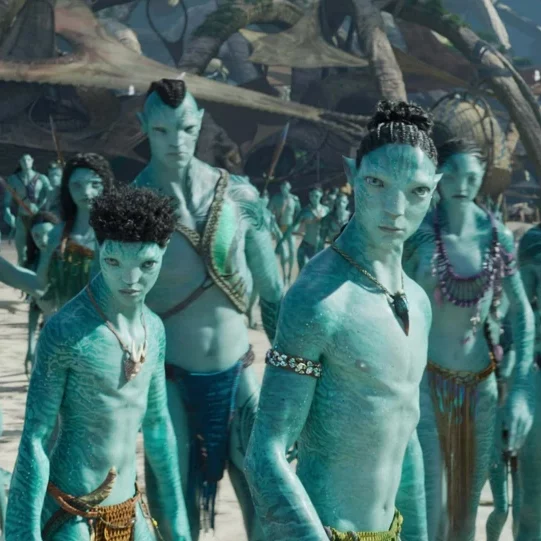 Na’vi skin is hairless except for the cranium and the tip of the tail, and contains cyanin, a pigment that produces colors in the blue, purple and cyan spectrum. Na’vi blood is red, utilizing an iron compound similar to hemoglobin to transport oxygen. The interaction of skin pigment with subsurface blood flow creates the characteristic blue and purplish shades of Na’vi skin color. Pigment patterns vary widely but are generally bands and stripes of darker blues on a field of lighter blue and cyan tones. The pigment becomes darker and shifts toward purple with long exposure to sunlight. The pigment attenuates in density on the palms of the hands, the soles of the feet, and the inside surface of the ear cartilage.
Na’vi skin is hairless except for the cranium and the tip of the tail, and contains cyanin, a pigment that produces colors in the blue, purple and cyan spectrum. Na’vi blood is red, utilizing an iron compound similar to hemoglobin to transport oxygen. The interaction of skin pigment with subsurface blood flow creates the characteristic blue and purplish shades of Na’vi skin color. Pigment patterns vary widely but are generally bands and stripes of darker blues on a field of lighter blue and cyan tones. The pigment becomes darker and shifts toward purple with long exposure to sunlight. The pigment attenuates in density on the palms of the hands, the soles of the feet, and the inside surface of the ear cartilage.
All Na’vi have a long, prehensile tail. This is used for balance, acting as a moving countermass to smooth out the stride at a full run, and to assist with direction changes. The tail is also used for social cues regarding emotional states, as are the ears. Some Na’vi subspecies can suspend their weight from their tail, but the Na’vi in the Hell’s Gate region cannot. They have been observed however using the prehensile tip of the tail to grip tree limbs and vines during climbing, and to help arrest a fall.
 The Na’vi skull is proportionately small, compared to a human head/body ratio, and is characterized by high cheekbones, feline ears and a protruding snout. The neck is twice as long as an average human and can rotate, owl-like, almost 180 degrees.
The Na’vi skull is proportionately small, compared to a human head/body ratio, and is characterized by high cheekbones, feline ears and a protruding snout. The neck is twice as long as an average human and can rotate, owl-like, almost 180 degrees.
Na’vi eyes are large and adapted for nocturnal hunting. The eye is four times human size, by volume, and the iris is gold to greenish-yellow for most Na’vi. Aquatic Na’vi have green or blue eyes. Pupils will retro-reflect green light at night, due to a layer of light amplifying cells in the retina.  The eyes are oriented well forward, as with most predators, for binocular vision. Na’vi are known to process stereopsis at a much finer level than the human visual system, and can detect the range and speed of moving objects two to three times more accurately than humans can.
The eyes are oriented well forward, as with most predators, for binocular vision. Na’vi are known to process stereopsis at a much finer level than the human visual system, and can detect the range and speed of moving objects two to three times more accurately than humans can.
 Bioluminescent skin cells that produce the noctilucase enzymes emit light when ambient light levels are low. These cells are grouped in lines and patterns of dots that are specific to each individual, and these markings are used by scientists to identify individuals during the study of group dynamics and social interactions, when recorded with photomultiplier cameras. Na’vi emotional states affect the level and to some extent the spectrum of light emitted by the dots, but it is not known if the Na’vi have conscious control of this, as a form of communication.
Bioluminescent skin cells that produce the noctilucase enzymes emit light when ambient light levels are low. These cells are grouped in lines and patterns of dots that are specific to each individual, and these markings are used by scientists to identify individuals during the study of group dynamics and social interactions, when recorded with photomultiplier cameras. Na’vi emotional states affect the level and to some extent the spectrum of light emitted by the dots, but it is not known if the Na’vi have conscious control of this, as a form of communication.
 The Reef People are a Na’vi subspecies adapted for an aquatic lifestyle. They make up over fifty clans.
The Reef People are a Na’vi subspecies adapted for an aquatic lifestyle. They make up over fifty clans.
Reef People’s skin is a greener hue than that of the land-dwelling Na’vi, with more mottled markings of stripes, swirls, and spots for better camouflage in the water.
Their tails are wider and paddle-like, with no hair on the tip, and their arms and hands are broad, to aid in swimming in the ocean. The body in general is less slender and more muscular. The torso is thicker to accommodate larger lungs, as the Reef People are skilled freedivers.
Reef People’s eyes are cyan, with nictitating membranes for perfect vision underwater, and their ears are slightly smaller. The Metkayina are the biggest clan of Reef People.